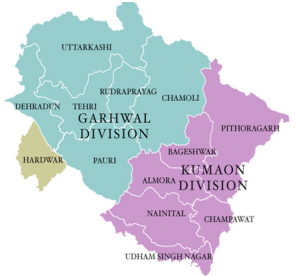Devbhoomi Uttarakhand
ArticleAlmora, Bageshwar, Chamoli, Champawat, Dehradun, Devbhoomi, Garhwal, Haridwar, Kumaon, Lands Of God, Nainital, Pauri Garhwal, Pithoragarh, Rudraprayag, Tehri Garhwal, Udham Singh Nagar, Uttarakhand, UttarkashiWith 3 comments
Devbhoomi Uttarakhand
UUttarakhand (उत्तराखंड), formerly Uttaranchal, is a state in the northern part of India. It is often referred to as the “Land of the Gods” Devbhoomi Uttarakhand (Hindi: देवभूमि) due to the many holy Hindu temples and pilgrimage centres found throughout the state. Devbhoomi Uttarakhand is known for its natural beauty of the Himalayas, the Bhabhar and the Terai. On 9 November 2000, this 27th state of the Republic of India was carved out of the Himalayan and adjoining northwestern districts of Uttar Pradesh. It borders the Tibet Autonomous Region on the north; the Mahakali Zone of the Far-Western Region, Nepal on the east; and the Indian states of Uttar Pradesh to the south and Himachal Pradesh to the northwest. The state is divided into two divisions, Garhwal and Kumaon, with a total of 13 districts. The provisional capital of Uttarakhand is Dehradun, the largest city in the region, which is a railhead. The high court of the state is in Nainital.
Archaeological evidence support the existence of humans in the region since prehistoric times. Among the first major dynasties of Garhwal and Kumaon were the Kunindas in the 2nd century BCE who practised an early form of Shaivism. Ashokan edicts at Kalsi show the early presence of Buddhism in this region. During the medieval period the region was consolidated under the Kumaon and Garhwal kingdom. By 1803 the region fell to the Gurkha Empire of Nepal and with the conclusion of the Anglo-Nepalese War in 1816 most of modern Uttarakhand was ceded to the British as part of the Treaty of Sugauli. Although the erstwhile hill kingdoms of Garhwal and Kumaon were traditional rivals, the proximity of different neighbouring ethnic groups and the inseparable and complementary nature of their geography, economy, culture, language, and traditions created strong bonds between the two regions which further strengthened during the movement for statehood in the 1990s.
The natives of the state are generally called either Garhwali or Kumaoni depending on their place of origin. According to the 2011 census of India, Uttarakhand has a population of 10,116,752, making it the 19th most populous state in India. A large portion of the population consists of Rajputs and Brahmins. More than 88% of the population follow Hinduism. Muslims are the largest minority in the state with Sikhs, Christians, Buddhists, and Jains being the other major religions. Garhwali and Kumaoni along with other hilly dialects and sub-dialects are the main regional languages, whereas Hindi is the most widely spoken language. Uttarakhand is the only state in India with Sanskrit as one of its official languages.
Two of the most important rivers in Hinduism originate in the region, the Ganga at Gangotri and the Yamuna at Yamunotri. These two along with Badrinath and Kedarnath form the Chota Char Dham, a holy pilgrimage for the Hindus. The state hosts the Bengal tiger in Jim Corbett National Park, the oldest national park of the Indian subcontinent. The Valley of Flowers, a Unesco World Heritage Site located in the upper expanses of Bhyundar Ganga near Joshimath in Gharwal region, is known for the variety and rarity of its flowers and plants.
There are 13 districts in Uttarakhand which are grouped into two divisions, Kumaon and Garhwal. Four new districts named Didihat, Ranikhet, Kotdwar, and Yamunotri were declared by the then CM of Uttarakhand, Ramesh Pokhriyal, on 15 August 2011.
The Kumaon division includes the following districts:
The Garhwal division includes the following districts:- Dehradun
- Haridwar
- Tehri Garhwal
- Uttarkashi
- Chamoli
- Pauri Garhwal (commonly known as Garhwal)
- Rudraprayag
Each district is governed by a district commissioner or district magistrate. The districts are further divided into sub-divisions, which are governed by sub-divisional magistrates; sub-divisions comprise blocks containing panchayats (village councils) and town municipalities.
According to the 2011 census, Haridwar, Dehradun, and Udham Singh Nagar are the most populous districts, each of them having a population of over one million.

nice
Nice Info.
Pingback: Harela Great Significance Uttarakhand | The Farm Festival of Uttarakhand.